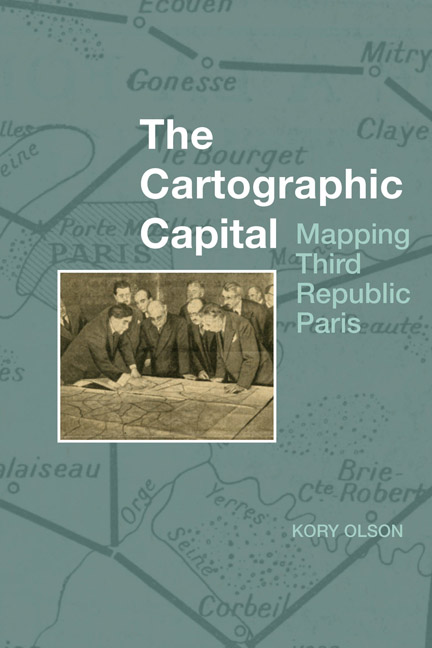Book contents
- Frontmatter
- Contents
- List of Figures
- Acknowledgements
- Introduction: Creating Republican Paris
- 1 Working with Maps
- 2 Creating Map Readers: The Rise of Geography and Cartography in Nineteenth-Century France
- 3 The Triumphant Republic: ‘Paris en 1889, les opérations de voirie exécutées entre 1871 et 1889’
- 4 A New Way of Seeing Paris: The Service Géographique's Carte de France
- 5 The Beginning of French Urbanism: Léon Jaussely's 1919 Plan d'extension
- 6 The Rise of Suburban Paris: Henri Prost's Carte générale
- Conclusion
- Bibliography
- Index
1 - Working with Maps
- Frontmatter
- Contents
- List of Figures
- Acknowledgements
- Introduction: Creating Republican Paris
- 1 Working with Maps
- 2 Creating Map Readers: The Rise of Geography and Cartography in Nineteenth-Century France
- 3 The Triumphant Republic: ‘Paris en 1889, les opérations de voirie exécutées entre 1871 et 1889’
- 4 A New Way of Seeing Paris: The Service Géographique's Carte de France
- 5 The Beginning of French Urbanism: Léon Jaussely's 1919 Plan d'extension
- 6 The Rise of Suburban Paris: Henri Prost's Carte générale
- Conclusion
- Bibliography
- Index
Summary
The hidden agenda of mapping, including cartography's modern claim to accuracy of representation, is precisely what makes them interesting and problematic texts, first in the silence of the maps (those elements of the landscape that are omitted) and second (and often related to the first), in terms of the implicit and explicit authoritarian nature of the map as a tool of power.
—Harley, The New Nature of Maps, 14There are both challenges and insights to be gained from working with maps. To begin with, maps are a form of communication, yet each individual reads them in accordance with his or her existing, socially and culturally defined, geographical conceptions (Edney, ‘Harley’ 48). Therefore, deciphering a map-maker's message and determining his or her audience represents a fundamental task before proceeding with any cartographic investigation. For a nation such as France, with inadequate access to education prior to the Third Republic, establishing who would see and understand a published map marks an important first step in any such investigation. Until Jules Ferry's educational reforms and Vidal de la Blache's efforts added geography to the national curriculum, most citizens had little or no access to – or familiarity with – cartography. The small public who could read and understand maps restricted the medium's reach and effectiveness. Yet, once the French map-reading public started to grow, so did cartography's influence.
Limited map contact mirrored a general lack of national or regional mobility. Throughout most of the nineteenth century, only a very small percentage of the population had the means to board a train and visit Paris. Even short trips were difficult and expensive undertakings (Weber, Peasants 198). Factors such as these restricted the formation of a common French identity and slowed any potential effectiveness of national maps, along with any need or expectation to ‘see’ what France, or any particular region, looked like on a map. Once the Third Republic improved exposure to cartography, however, it could begin to appropriate the medium into its mission of creating citizens and use the science to learn more about itself. This newly acquired knowledge will also provide the necessary tools to view and understand the national terrain.
- Type
- Chapter
- Information
- The Cartographic CapitalMapping Third Republic Paris, 1889-1934, pp. 20 - 46Publisher: Liverpool University PressPrint publication year: 2018



